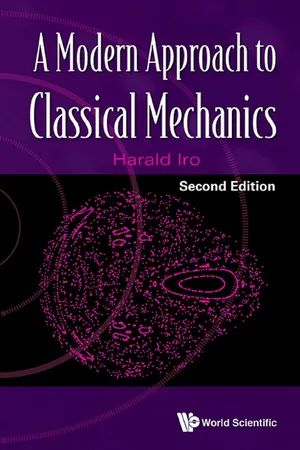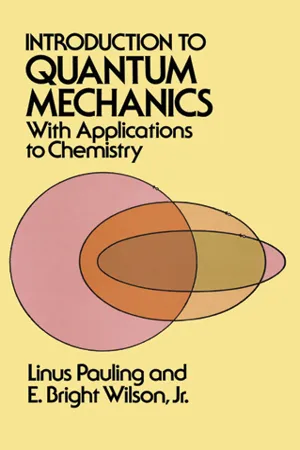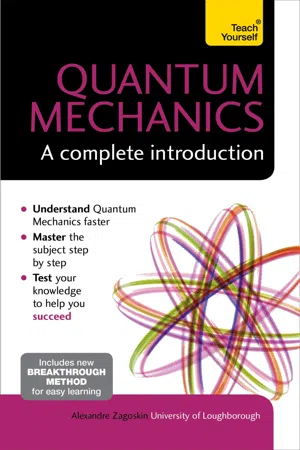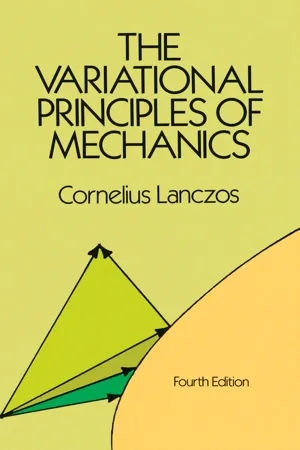Physics
Hamilton's Equations of Motion
Hamilton's equations of motion are a set of equations used to describe the dynamics of a physical system. They are derived from the principle of least action and provide a powerful alternative formulation of classical mechanics. The equations express the evolution of a system in terms of generalized coordinates and momenta, offering a more elegant and efficient approach to solving complex mechanical problems.
Written by Perlego with AI-assistance
Related key terms
Related key terms
1 of 4
Related key terms
1 of 3
7 Key excerpts on "Hamilton's Equations of Motion"
- eBook - ePub
- Harald Iro(Author)
- 2015(Publication Date)
- WSPC(Publisher)
13Hamiltonian mechanics
In Lagrangian mechanics, the equations of motions are Lagrange’s equations for the action integral S (cf. Chapter 9 ). For the actual orbit, the action integral is extremal,Starting from this principle (see Section 9.3.4 ), W.R. Hamilton developed the most unified and elegant account of classical dynamics.Hamilton’s approach to classical mechanics was an essential prerequisite for the development of quantum mechanics – the theory of ‘atomic mechanics’ – that started to grow at the beginning of the 20th century.13.1 Hamilton’s equations of motion in phase space
The Lagrangian of a point mass with a single degree of freedom is a function of the independent variables q, , and t:Emphasizing the conjugate momentum (9.77) in view of its of its importance to the existence of conserved quantities, one could summarize Lagrangian theory by the equations:But this form is not particularly useful; one has only added a variable, namely p. Rather, it may be favorable to introduce q and p, instead of q and , as independent variables.This change is achieved by applying a Legendre transformation to the Lagrangian L. In this transformation, the derivative of the function in question (L) with respect to one of its arguments ( ) is introduced as new variable (p); in the process, a new function H(q, p, t) is constructed in place of L(q, , t). To find H, we use p = ∂L/∂ to rewrite the total (i.e. exact) differential of L,in the form Collecting the total differentials appearing on both sides, we obtaindH is the total differential of the function H = p − L (The sign is chosen by convention.). Eq. (13.2) shows that the independent variables1 are q, p, and t. Comparing Eq. (13.2) to total differential of H,yields the relationsThese three equations are in fact generally true for any two functions related by a Legendre transformation. The first and the last relations are typical for all variables not affected by the transformation (here, these are q and t; the sign results from the choice of sign for H). Conversely, the Lagrangian L is the Legendre transform of H, in which one switches from independent variables q and p to the independent variables q and . The second equation in (13.4) plays the same role as p = ∂L/∂ in the transformation from L to H - eBook - ePub
- Robert Weinstock(Author)
- 2012(Publication Date)
- Dover Publications(Publisher)
lagrangian —as6-2. Hamilton’s Principle. Lagrange Equations of Motion(a ) Although Newton’s laws of motion are the most fundamental mathematical description of mechanical phenomena in general, it best suits the purposes of our study to assume the validity of Hamilton’s principle as the physical law which describes the motion of any system of the type considered in 6-1 above. The principle of Hamilton reads:The actual motion of a system whose lagrangian isis such as to render the (Hamilton’s) integralwhere t 1 and t 2 are two arbitrary instants of time , an extremum withrespect to continuously twice-differentiable functions q 1 (t ), q 2 (t ), …,qN(t )for which qi(t 1 )and qi(t 2 ) are prescribed for all i = 1, 2, …, N . We accept Hamilton’s principle as applicable to the motion of any conservative system.Although it is in some places stated that Hamilton’s principle may be used to replace Newton’s laws of motion as the fundamental starting point for mechanical systems possessing a lagrangian, it should be realized that Newton’s laws are implicitly employed in the preceding paragraphs in at least two ways: (i) The definition of mass resides in Newton’s third law. (ii) In the tacit assumption that our system of coordinates is fixed relative to an inertial frame of reference, we make use of Newton’s first law, by means of which an inertial frame is defined.(b ) With the result (57 ) of 3-8(a ) we conclude from Hamilton’s principle that the generalized coordinates describing the motion of a system of particles must satisfy the set of Euler-Lagrange equationsThe equations (8 ), Lagrange’s equations of motion, constitute a set of N simultaneous second-order differential equations, whose solution yields the functions q 1 (t ), q 2 (t ), …,qN(t ). The 2N constants involved in the general solution of (8 ) are evaluated when the initial (t = 0, for example) values of all theqiand (i = 1, 2, …, N ) are given. Once the initial state of the system is thus prescribed, its future motion is described in detail by the functions obtained through the solution of (8 - eBook - ePub
Emergence of the Quantum from the Classical
Mathematical Aspects of Quantum Processes
- Maurice de Gosson(Author)
- 2017(Publication Date)
- WSPC (EUROPE)(Publisher)
Like the movement of a symphony, a Hamiltonian flow involves a total ordering which implies the whole movement: Past, present, and future are actively present in any one movement. When we are listening to music we are actually directly perceiving an implicate order. This order is active because it is continuously flowing in emotional responses which are inseparable from the flow itself. Similarly, the solutions of Hamilton’s equations are uniquely determined for all bounded times and all locations close to the original one, exactly as in the symphony metaphor: if we observe during a tiny time interval the motion of a particle moving under the influence of a Hamiltonian flow, we see an unfoldment of the totality of the flow, which is uniquely determined by the past — and the future!There are nowadays many texts, at various levels, presenting Hamiltonian mechanics from the symplectic point of view; for instance the books by Arnold [5 ], Abraham et al. [2 ], Guillemin and Sternberg [139 , 140 ] are classical references; for good introductions to symplectic geometry from the modern point of view see [23 ].1.1. Hamilton’s Equations
1.1.1. The origins; examples
Most physical systems can be studied by using two specific theories originating from Newtonian mechanics, and having overlapping — but not identical — domains of validity. The first of these theories is “Lagrangian mechanics”, which essentially uses variational principles (e.g., the “least action principle”); it will not be discussed at all in this book; we refer to Souriau [268 ] (especially p. 140) for an analysis of some of the drawbacks of the Lagrangian approach. The second theory, “Hamiltonian mechanics”, is based on Hamilton’s equations of motionwhere the Hamiltonian functionis associated with the “vector” and “scalar” potentials A and V (both possibly depending on time t). We are writing r = (x, y, z) for the position vector, and p = (px , py , pz ) for the momentum vector. For A - Linus Pauling, E. Bright Wilson, E. Bright Wilson(Authors)
- 2012(Publication Date)
- Dover Publications(Publisher)
Hamiltonian function .2b. The Hamiltonian Function and Equations. —For conservative systems1 we shall show that the function H is the total energy (kinetic plus potential) of the system, expressed in terms of thepk's andqk's. In order to have a definition which holds for more general systems, we introduce H by the relationAlthough this definition involves the velocities k , H may be made a function of the coordinates and momenta only, by eliminating the velocities through the use of Equation 2–5 . From the definition we obtain for the total differential of H the equationor, using the expressions forpkand k given in Equations 2–5 and 2–6 (equivalent to Lagrange's equations),whence, if H is regarded as a function of theqk's andpk's, we obtain the equationsThese are the equations of motion in the Hamiltonian or canonical form .2c. The Hamiltonian Function and the Energy. —Let us consider the time dependence of H for a conservative system. We haveusing the same substitutions forpkand k (Eqs. 2–5 and 2–6) as before. H is hence a constant of the motion, which is called the energy of the system. For Newtonian systems, in which we shall be chiefly interested, the Hamiltonian function is the sum of the kinetic energy and the potential energy,expressed as a function of the coordinates and momenta. This is proved by considering the expression for T for such systems. For any set of coordinates, T will be a homogeneous quadratic function of the velocitieswhere theHence so that 2d. A General Example.aij's may be functions of the coordinates.- Halid Bikkin, Igor I. Lyapilin(Authors)
- 2014(Publication Date)
- De Gruyter(Publisher)
3 Kinetic equations in non-equilibrium statistical mechanics3.1 Description of non-equilibrium systems in statistical mechanics
3.1.1 Integrable and nonintegrable dynamical systems
Unfortunately, insufficient attention is given to non-integrable systems within a university course of lectures on classical mechanics. Such a situation requires a short excursion into mechanics of classical systems.As is known, a set of Hamilton’s dynamic equations:(3.1)is referred to as completely integrable if there exists a canonical transformation of the variables qi , pi , that results in transferring from the generalized coordinates qi and generalized impulses pi to the variables Ji , (action-angle) in terms of which the set of equations (3.1) may be written as [18]:(3.2)In equations (3.1) and (3.2) H is Hamilton’s function. The special role of such variables as action-angle is that the Hamiltonian in these variables depends only on integrals of motion Ji and does not depend on the angles αi . Obviously, that if these variables are found, the set of equations (3.2) is easily integrated:(3.3)For this reason, the main problem of mechanics is to find an appropriate canonical transformation, leading a system to the form of (3.2). Moreover, individual intuitive notions concerning behavior mechanical systems also have to do with exceptionally integrable systems.Meanwhile, the number of systems which are integrable is not great. Integrable systems certainly include a system with one degree of freedom. It is true, there are a few particular cases when systems with two- or three degrees of freedom can be reduced to a system with one degree of freedom, consequently to be also integrable. For example, systems consisting of non-interacting particles or a set of harmonic oscillators, reacting on each other according to a harmonic law may be regarded as systems with two- or three degrees of freedom. The above list of integrable systems has finished. All other systems are non-integrable, and their behavior may be very different- Alexandre Zagoskin(Author)
- 2015(Publication Date)
- Teach Yourself(Publisher)
. Remember that when we take a partial derivative with respect to one independent variable, we keep all others constant. Then indeedMoreover, for any function f of x, px (e.g. a probability distribution function) its time derivative will be, according to the chain rule and the Hamilton’s equations, a Poisson bracket of this function with the Hamilton function:If there are many pairs of conjugate variables, the formula remains the same. Only the Poisson bracket will now be the sum of contributions from all these pairs.The important physical insight from this equation is that the Hamilton function – that is, energy – determines the time evolution of any physical system. Time and energy turn out to be related in classical mechanics, almost like (but not quite) the position and momentum.What has this to do with quantum mechanics? A while ago Werner Heisenberg found out that quantum equations of motion for operators (Heisenberg equations) have the following form:1In particular, . Here the brackets denote the commutator of two operators.Key idea: RotationsA vector r can be rotated to become vector r’. This operation can be written as the action of the rotation operator Ô on vector r:It transforms the old coordinates (e.g. (x,y,z)) into the new ones (x’,y’,z’).This is a particularly simple operation in a two-dimensional space; a planar rotation by an angle α. Then the vector r can be represented as a column of two numbers, x and y, and the operator Ô as a two-by-two matrix.The Hamiltonian operator Ĥ is the quantum operator, which corresponds to the classical Hamilton function, i.e. the energy of the system. For example, for a harmonic oscillator it is simplyOne of the great insights of Paul Dirac was that these Heisenberg equations of motion are directly analogous to classical equations of motion written using Poisson brackets. One only needs to replace the classical functions and variables with quantum operators, and instead of a classical Poisson bracket put in the commutator divided by iħ:2And voilà! You have a quantum equation of motion. This is a much more consistent scheme of quantization than the one of Bohr–Sommerfeld.- eBook - ePub
- Cornelius Lanczos(Author)
- 2012(Publication Date)
- Dover Publications(Publisher)
For our mechanical problem this transformation accomplishes a great simplification of both kinetic and potential energies. The kinetic energy in the new reference system becomes while the potential energy becomes The Langrangian equations of motions are now:These differential equations are completely separated and easily integrable. They are the differential equations of simple harmonic motion, givingwhere Ai and Bi are arbitrary constants of integration.Problem: Consider a double pendulum, composed of two single pendulums of the same length and mass, the second being suspended from the bob of the first. Use as position coordinates the two infinitesimal angles θ and 6t between thread and plumb line.1. Form the kinetic energy and the potential energy of the system.2. Show from the form of the line element that the two axes Q1 and Q2 of the oblique reference system are at an angle of 45° to each other.3. Show that the two principal axes pl and p2 bisect the angle between Q1 and Q2 and its supplementary angle.4. Show that the frequencies connected with the two principal axes arewhere v is the natural frequency of each of the simple pendulums.We now have to distinguish between two fundamentally different possibilities. We know that the λi are always real numbers. But we cannot guarantee that they are always positive. In the general case some of the λi , may be positive and some negative. Let us assume that all λi are positive. In this case the solution (510.46 ) shows that the C-point oscillates around the point of equilibrium P. The motion consists of a superposition of monochromatic vibrations of frequencywith small but constant amplitudes and arbitrary phases. These vibrations occur in the direction of the n mutually orthogonal principal axes pi. The superposition of all these vibrations gives “Lissajous figures” in the n-dimensional configuration space. These vibrations are called “normal vibrations” on account of their mutual orthogonality. Their number is always equal to the number of degrees of freedom of the mechanical system. The frequencies Vi
Index pages curate the most relevant extracts from our library of academic textbooks. They’ve been created using an in-house natural language model (NLM), each adding context and meaning to key research topics.
Explore more topic indexes
Explore more topic indexes
1 of 6
Explore more topic indexes
1 of 4






